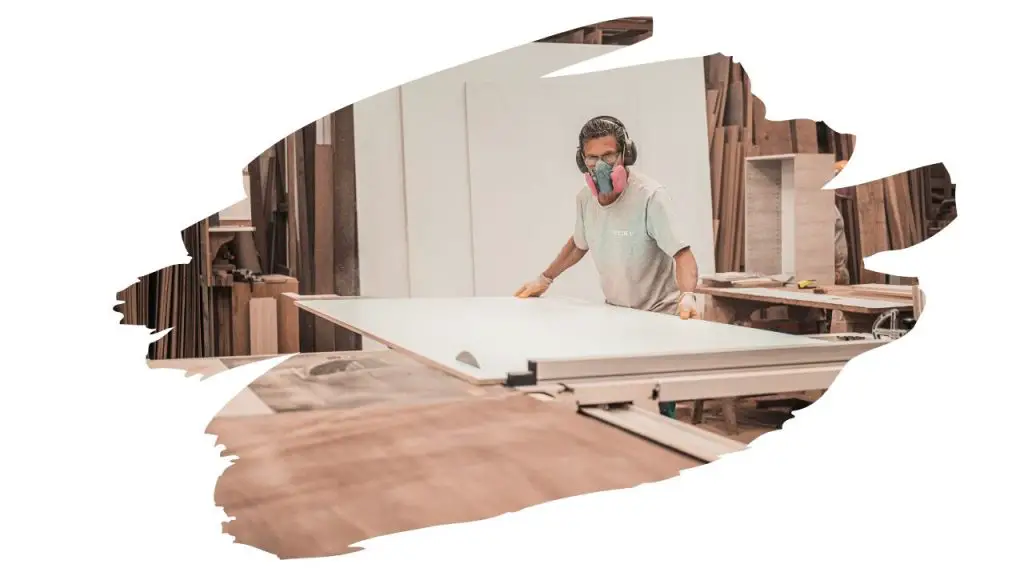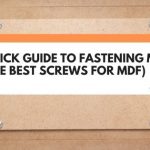If you’ve ever sought after low-priced wooden board, then MDF wood often comes up as a go-to recommendation.
It’s an all-purpose material, one that can handle a range of jobs from cabinets to shelving. And it doesn’t hurt that its price is easy on your bank account too.
That’s all well and good, of course, but what are some mdf wood disadvantages? Medium density fiberboard, better known as MDF, is weaker and less durable than other manufactured woods such as Plywood. It doesn’t hold screws and nails in well. And its dust contains carcinogenic formaldehyde.
And yet, despite these disadvantages, MDF continues to be an in-demand material used in everything from furniture to construction.
And just why is that? Well, keep reading to learn more about this cost-effective wood…

This post may contain affiliate links to products that we receive a commission for (at no additional cost to you). Learn more here.
The 4 Key MDF Wood Disadvantages
1 – MDF Wood Is Weaker Than Natural Wood
You do not want to use this wood for any load-bearing structure. It might be heavier compared to other manufactured woods, such as plywood, but that doesn’t mean it can support high loads or much weight.
In other words, if you want to make a good shelf, skip over MDF and go for something stronger, such as plywood.
There is more to manufactured woods than just MDF and Plywood. Click here to learn more: Just What Is Manufactured Wood Anyway?
MDF Furniture Durability
In short, MDF furniture is rarely long for this world. It is easily damaged, and it takes a fair amount of work to repair.
And don’t even think about using this material for shelving.
You can make it work by reinforcing it with adequate support and not putting anything too heavy on it. But, generally speaking, this isn’t a great choice for load-bearing.
You see, when it comes to MDF load-bearing strength, it’s all boils down to wood fiber compression.
That compression doesn’t make this material any stronger. Especially compared to other manufactured woods, such as Plywood.
And this is all before you even factor in the fact that screws tend to come loose too easily when drilled into MDF board.
MDF vs Plywood
If you really want a manufactured wood that is able to handle loads, then plywood is less likely to buckle under the pressure.
Provided that you reinforce it, plywood is easily the better choice when it comes to making furniture of all kinds – particularly any piece that will need to hold up under heavy weights – such as tables and shelves.
2 – MDF Is More Water Absorbent Than Natural Wood
You are going to have to seal MDF up like a tomb, because this manufactured wood is more than happy to soak up any water droplet it comes across.
This will prove a problem, as the constant swelling (with water) and compression (as it dries) will crack and splinter the paintwork.
That’s why MDF is preferably used as underlayment, instead of flooring. It does its best work as the insulating material that lies in-between the subfloor and floor.
If you’d like to learn more about this topic, read our article: Can You Really Use MDF For Flooring (Or Is It A Bad Idea?)
Yet, funnily enough, MDF does hold up surprisingly well against humidity. Which is why it is best you should only use MDF on indoor furniture (except Kitchen area pieces), and avoid using it on any outdoor setups.
3 – MDF Does Not Work Well With Nails Or Screws
This engineered wood type is made up of very fine particles, which means there is very little for nails or screws to ‘grip’ onto.
This can be a problem when it comes to holding shelving in place (last thing you want is for it to collapse and break everything on it).
4 – MDF dust contains formaldehyde
Formaldehyde is something you do not want to be breathing in. This resin, used as an adhesive when manufacturing MDF, is a carcinogen that cause cancers in humans.
In fact, in 1994, it was rumored that because of its formaldehyde content, MDF was on the verge of being banned in both Australia and the United States.
The 3 Main MDF Wood Advantages
1 – Wood Knots And Voids Are Not A Problem
Compared to natural wood, MDF doesn’t have a problem when it comes to knots and sap seepage.
And voids are null and void (pardon the pun) when you contrast it against Plywood.
2 – It Is Cheaper Than Most Other Wood (Including Plywood)
Although this is more of a general rule of thumb, as in some cases, MDF can sometimes turn out to be a little bit pricier than its alternatives.
It all depends on where you are purchasing your MDF boards from, and the thickness of the boards you are purchasing.
3 – Its Smooth Surface Holds Paint Easily
Anyone who has struggled through the pain of having to apply endless coats of paint – just to get that perfect even finish – will find MDF’s smooth surface a relief to work with.
No splinters, knots or chips mar the smooth even surface of this fiberboard. Which means that your paint job stays on with little fan-fare.
Final Thoughts
If you planned on using MDF board, you might want to consider whether it really is the best option.
You now know that the key MDF wood disadvantages are;
- It has low durability
- Doesn’t hold screws/nails securely
- Its wood dust contains formaldehyde
- Its not very water resistant
At the end of the day, you want to make sure that the wood you are choosing to work on is safe – both for yourself and for everyone around you.
References
https://www.theguardian.com/uk/1997/sep/21/antonybarnett.theobserver



